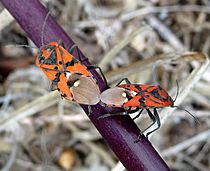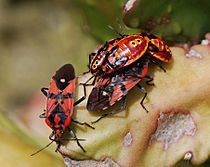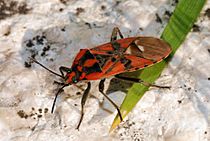Spilostethus pandurus facts for kids
Quick facts for kids Spilostethus pandurus |
|
|---|---|
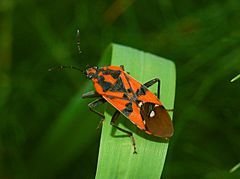 |
|
| Spilostethus pandurus, upperside | |
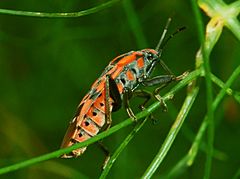 |
|
| Side view | |
| Scientific classification | |
| Kingdom: | |
| Phylum: | |
| Class: | |
| Order: | |
| Suborder: | |
| Infraorder: |
Pentatomomorpha
|
| Superfamily: |
Lygaeoidea
|
| Family: |
Lygaeidae
|
| Subfamily: |
Lygaeinae
|
| Genus: |
Spilostethus
|
| Species: |
S. pandurus
|
| Binomial name | |
| Spilostethus pandurus (Scopoli, 1763)
|
|
| Synonyms | |
|
|
Spilostethus pandurus is a type of insect often called a "seed bug." It belongs to a family of bugs called Lygaeidae. These bugs are known for their bright colors and for eating seeds from various plants.
Contents
Where the Name Comes From
A scientist named Scopoli first described this bug in 1763. He found it near Ljubljana. We're not sure why he chose the name "pandurus." It might be named after a group of soldiers called the Panduri. These soldiers were part of the Habsburg monarchy.
Different Types of Spilostethus pandurus
Just like there are different types of dogs, there are different types of Spilostethus pandurus. These are called subspecies. Here are some of them:
- S. pandurus subsp. pandurus (Scopoli, 1763): You can find this type in many parts of Europe, Africa, and Asia. This includes countries like France, Germany, Italy, Egypt, and India.
- S. pandurus subsp. militaris (Fabricius, 1775): This subspecies also lives in many European and African countries. Some places include Belgium, Greece, Portugal, and Senegal.
- S. pandurus subsp. elegans (Wolff, 1802): This type is found in Central and Southern Africa. It also lives in the Canary Islands, India, and Israel.
- S. pandurus subsp. asiaticus (Kolenati, F.A., 1845): This subspecies is found in Madagascar.
- S. pandurus subsp. tetricus (Horvath, G., 1909): This type lives on the Canary and Madeira islands.
Where These Bugs Live
You can find Spilostethus pandurus bugs in many places. They live across Europe, the Mediterranean region, and parts of Asia. They are more common in warmer, southern areas.
They are found in countries like Albania, France, Germany, Italy, Greece, Spain, and Turkey. You can also spot them in parts of Africa and as far east as India and China.
What They Look Like
Spilostethus pandurus bugs are about 13 to 15 millimeters long. That's about half an inch! Their bodies are a mix of bright red and black colors. They have a white spot in the middle of their wings.
Their upper body, called the pronotum, has two wide, wavy black stripes. These stripes run from the front to the back. The scutellum, a small shield-like part on their back, is black. Sometimes it has a tiny red spot.
Baby bugs, called nymphs, are bright red with black marks. These bugs have special glands that can release bad-smelling stuff. This helps to keep predators away!
What They Eat
These bugs are known as "polyphagous." This means they eat many different kinds of plants. They especially like to feed on the flowers and seeds of plants from the family Apocynaceae.
In Europe, they often feed on plants that can be toxic. Examples include jimsonweed (Datura stramonium) and oleander (Nerium oleander).
Spilostethus pandurus can sometimes cause problems for farmers. They can damage crops like Sesamum indicum, Calotropis gigantea, and Calotropis procera. They also attack other important crops. These include sorghum (Sorghum bicolor), Eleusine coracana, Pennisetum americanum, and Arachis hypogaea. They can even feed on tomatoes, tobacco, and sunflowers.
Gallery
See also
 In Spanish: Spilostethus pandurus para niños
In Spanish: Spilostethus pandurus para niños


